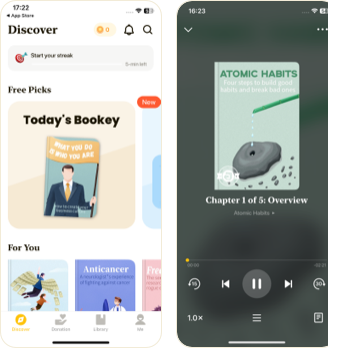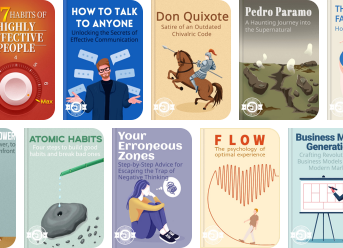Last updated on 2025/07/22
The Five Love Languages Summary
Gary Chapman
Discover Your Partner's Unique Love Language
Last updated on 2025/07/22
The Five Love Languages Summary
Gary Chapman
Discover Your Partner's Unique Love Language
Description

How many pages in The Five Love Languages?
208 pages
What is the release date for The Five Love Languages?
In "The Five Love Languages," Gary Chapman unveils a transformative approach to understanding and nurturing relationships, advocating that love is not a one-size-fits-all experience. He introduces the concept that each individual has a unique love language—Words of Affirmation, Acts of Service, Receiving Gifts, Quality Time, and Physical Touch—that dictates how they give and receive love. By identifying and learning to speak the love language of your partner, Chapman argues, couples can bridge emotional gaps and cultivate deeper, more fulfilling connections. This engaging guide not only helps partners communicate their feelings more effectively but also empowers them to create lasting intimacy and appreciation in their relationships. Dive into this insightful read to discover how decoding your love language can lead to a richer, more harmonious love life.
Author Gary Chapman
Gary Chapman is a renowned author, speaker, and counselor with over 30 years of experience in the field of marriage and family relationships. Born on January 10, 1938, in the small town of Little Rock, Arkansas, he holds a Ph.D. in adult education from Southwestern Baptist Theological Seminary and has served as a pastor for over three decades. Chapman is best known for his groundbreaking book, "The Five Love Languages," which explores the different ways people express and receive love in relationships, and has sold millions of copies worldwide, making it a staple in the self-help genre. Through his teachings, workshops, and writing, Chapman has impacted countless individuals and couples, helping them to build more fulfilling and lasting relationships.
The Five Love Languages Summary |Free PDF Download
The Five Love Languages
Chapter 1 |
In exploring the profound concept of love, Gary Chapman highlights its pivotal role in human life, emphasizing its universal confusion and importance. Love is often romanticized, featured prominently across countless forms of media, and regarded as the quintessential emotional need by psychologists. The Apostle Paul encapsulates this notion, stating that love outshines all other human virtues, underscoring that love must motivate our actions to give them meaning. The multifaceted nature of love complicates its understanding—ranging from affection for objects and activities to deep emotional connections with people. This ambiguity extends into the realm of behavior, where love is often cited as the justification for various actions, which can sometimes be misinterpreted or misapplied in harmful ways. For instance, parents may equate indulgence with love, while professionals may label it as irresponsible. A critical theme in this discourse is the concept of an "emotional love tank." Drawing from child psychology, Chapman introduces the idea that every individual possesses an emotional reservoir that requires filling with love and affection. This need is especially pronounced in children, whose behavioral issues often stem from an empty love tank. Misbehavior, he suggests, is frequently a misguided attempt to seek love. Chapman recounts real-life examples, such as a girl named Ashley, whose actions stemmed from an unfulfilled need for love following the trauma of her parents' divorce—demonstrating how an empty love tank can lead to serious emotional and relational challenges. The need for love persists into adulthood and marriage, where the initial euphoric phase of love can create a temporary sense of fulfillment but ultimately reveals underlying emotional requirements once the novelty wears off. The essence of marital satisfaction hinges on the capacity to feel loved by one's spouse. Chapman illustrates this through poignant statements from couples, crystallizing the idea that material possessions mean little without emotional connection. Central to human existence is the desire for intimacy; marriages are crafted to fulfill this need. Yet, couples often find themselves in painful situations, expressing that love has diminished and needs remain unmet, indicating that adults also harbor emotional love tanks. With such needs laid bare, Chapman questions whether many marital conflicts could stem from an emptiness at their core. He postulates that filling this emotional reservoir may revive relationships and create an environment conducive to healthy communication and conflict resolution. His insights come from decades of counseling couples, forging a deeper understanding of marital dynamics through real-life experiences. Chapman asserts that maintaining a full love tank is crucial to the health of a marriage, akin to how a vehicle requires proper oil levels to function effectively. His forthcoming exploration of the five love languages promises to elucidate how understanding and speaking one's spouse’s primary love language could transform their relationship, enabling individuals to flourish emotionally when their tanks are replenished. In summary, the critical insight into maintaining loving relationships involves recognizing and addressing the fundamental need for love in both children and adults. Emphasizing the emotional love tank concept serves as a reminder of the importance of love in cultivating healthy, lasting connections. Through nurturing these emotional reservoirs, Chapman suggests that couples can potentially revive their love lives, enhancing both individual well-being and relational satisfaction.
Key Point: Understanding and filling your emotional love tank is essential for healthy relationships.
Critical Interpretation: Imagine waking up each morning with a profound understanding that your emotional well-being relies heavily on love—both given and received. Gary Chapman's concept of the 'emotional love tank' serves as a vibrant reminder that nurturing your own emotional needs and those of your loved ones can transform the fabric of your relationships. By actively recognizing when your tank is running low and taking steps to fill it through loving actions and words, you equip yourself to forge deeper connections and navigate conflicts more effectively. Picture yourself fostering an environment where love flourishes, leading not only to a more fulfilling partnership but also to personal growth and emotional resilience, enabling you to embrace life's challenges with a heart full of love.
Chapter 2 |
In the narrative of love, we encounter Janice, a woman who epitomizes the thrilling highs of falling in love. After years of searching, she arrives at the realization that she is getting married to David, a man she has known for only three weeks. This exhilarating proclamatory moment illustrates a common phenomenon; the euphoric feeling of being "in love" can lead individuals to believe they have found their perfect match. Janice's experience reflects a universal sentiment: the initial stages of romantic relationships are often characterized by intense passion and a strong emotional connection that feels irresistible and transformative. This "in love" experience typically begins with an undeniable attraction—an electric spark that prompts couples to engage in exploration of each other's personalities and life stories. This phase is marked by thrill-seeking activities, where every interaction fuels an emotional high. For many, this culminates in dreams of future blissful union; they are often captivated by the idea that their love will last forever, oblivious to the fact that this emotional euphoria is temporal. However, this honeymoon phase is frequently misleading. Research suggests that the intensity of such infatuations peaks and subsequently diminishes within approximately two years—leaving couples confronting the reality of their partners’ imperfections. Before long, the once-idyllic relationships may spark conflicts over mundane issues like habits and preferences, transforming the partnership into a battleground rather than a sanctuary of love. Entering the marriage life with the misconception that the "in love" experience will endure inevitably leads to disillusionment. Many individuals face the harsh reality that true intimacy and conflict resolution are necessary components of a successful relationship. Infatuation often blinds partners to the complexity of each other's personalities, resulting in discord when the initial magic fades. The misunderstanding surrounding the nature of "in love" sentiments stems from the belief that such obsession can sustain a partnership. Emotions are complex and hinder rational thinking, which can lead to unrealistic expectations regarding ease of relationship satisfaction. In time, the day-to-day challenges of marriage highlight that true love is not merely an instinctual reaction, but rather a purposeful commitment that necessitates effort, growth, and a conscious choice. As love matures beyond initial obsession, couples are encouraged to build genuine emotional connections rooted in understanding and mutual respect. Real love transcends fleeting feelings; it is an act of the will that combines affection with accountability, requiring partners to choose growth and care for one another intentionally. In understanding the foundations of lasting love, marriage can evolve from initial emotional highs to a more profound, stable relationship characterized by fulfillment and security. The emotional need to feel loved remains essential for marital health; when partners actively express love in ways that resonate with one another, they foster an environment where both individuals can flourish. In essence, while the infatuation of falling in love serves as a captivating introduction, the true narrative of a successful marriage unfolds through commitment, understanding, and the nurturing of each partner's emotional needs. Exploring the five emotional love languages will illuminate pathways for couples to express love effectively, transforming a superficial connection into a deeply fulfilling partnership. Recognizing love as an intentional choice—rather than an elusive feeling—provides a foundation for enduring happiness and the capacity for optimal emotional health within marriage.
Key Point: Love is a deliberate choice, not just an emotion.
Critical Interpretation: As you navigate through your relationships, let this powerful realization sink in: love requires intentionality. Rather than relying solely on the thrill of infatuation, embrace the understanding that true love demands conscious effort, deep understanding, and ongoing commitment. By recognizing love not just as a fleeting feeling but as a daily decision to nurture and support your partner, you can build a relationship that withstands the test of time. Imagine waking up each day, not simply caught in the euphoria of 'being in love,' but choosing to express that love through thoughtful actions and meaningful conversations. This shift from expecting constant emotional highs to appreciating the depth of an intentional connection can profoundly transform your relationship, fostering a sense of security and fulfillment that deepens your bond and creates a lasting partnership.
Chapter 3 |
In Chapter Four of "The Five Love Languages," Gary Chapman delves into the first love language: Words of Affirmation. This chapter emphasizes the transformative power of verbal expressions of love, highlighting its essential role in maintaining emotional connection within a marriage. The narrative begins by quoting Mark Twain, who believed that compliments can sustain emotional well-being, suggesting that regular verbal affirmations are crucial for partners in a romantic relationship. 1. The importance of words of affirmation is illustrated through the words of King Solomon, who noted the potential of words to uplift or devastate. Simple, sincere verbal compliments can create a positive emotional environment. For instance, affirmations such as “You look sharp in that suit” or expressions of gratitude for everyday tasks can significantly enhance the emotional climate of a marriage. Chapman recounts a story of a woman frustrated by her husband’s inaction regarding home improvements, revealing how verbal compliments could yield richer results than nagging. By shifting her communication from demands to affirmations, she saw her husband respond constructively, emphasizing that the essence of love is not to get what one wants but to promote the well-being of the partner. 2. Encouragement emerges as another important dialect of verbal affirmation. This involves inspiring courage in one’s spouse, helping them cultivate their abilities and aspirations. The story of Allison, who rekindles her passion for writing through her husband Keith’s support, exemplifies how words can unlock potential. The chapter stresses that true encouragement should stem from a place of empathy and understanding, rather than from a desire to pressure the spouse into conforming to one's own expectations. 3. Kindness in communication is critical. Chapman explains that the manner in which something is said often holds more power than the actual words. A kind delivery can express love even when addressing grievances, while a harsh tone can warp a loving intent. The anecdote about a couple navigating their emotions showcases the necessity of understanding and soft responses to maintain intimacy. 4. Additionally, humility plays a vital role in communication. Demands can undermine equality in a relationship and should be replaced with requests that affirm the partner’s autonomy and decision-making power. By framing desires as requests rather than ultimatums, partners can foster intimacy and mutual respect, enhancing emotional connection. 5. Within the love language of Words of Affirmation, several dialects exist, each focusing on different forms of verbal affirmation. Chapman encourages individuals who may not naturally express themselves verbally to practice affirmations daily, suggesting tools like journals to collect positive affirmations. He highlights the impact of indirect affirmation and how public acknowledgment of a partner's strengths can amplify feelings of love and appreciation. 6. Closing with an insightful reflection on a couple who nearly lost their relationship, Chapman emphasizes that the discovery of each partner’s love language is crucial. While one spouse thrives on affirming words, the other's needs may differ significantly. The chapter ends with practical suggestions to enhance the expression of Words of Affirmation in a relationship, such as noting daily compliments, writing love letters, and acknowledging each other’s strengths. Ultimately, this chapter serves as a guide for couples to recognize and utilize the strength of verbal affirmations, underscoring that in nurturing a love language, the words spoken (or not spoken) can profoundly impact the relationship's vibrancy and connection.
Key Point: The transformative power of verbal expressions of love
Critical Interpretation: Imagine waking up each day and consciously choosing to express words of affirmation to your partner. As you offer genuine compliments and words of encouragement, you begin to see a beautiful shift in the emotional atmosphere of your relationship. You’ll notice how simple phrases like ‘You did an amazing job’ or ‘I appreciate everything you do’ can ignite a spark of joy and appreciation in your partner’s eyes. This chapter inspires you to harness the power of your words to uplift and motivate, creating a nurturing environment that fosters closeness and respect. You’ll realize that by investing in affirming communication, you aren't just helping your partner thrive, but also cultivating a deeper bond that enriches both your lives.
Chapter 4 |
In Chapter 5 of "The Five Love Languages," Gary Chapman delves into the second love language: quality time. He illustrates this concept through the story of Betty Jo and her husband Bill, emphasizing how vital undivided attention is in a relationship. Here are the key points: 1. Understanding Quality Time: Quality time involves giving your full attention to your partner. It is not simply sitting together while engaged in separate activities, like watching television, but rather it means interacting in meaningful ways—talking, walking, or dining without distractions. The essence of quality time is about connection and shared experiences that affirm love and commitment. 2. Unique Love Languages: Chapman points out the critical error in assuming that the way one person feels loved—through words of affirmation, for instance—translates similarly for another. In Betty Jo's case, her need was for Bill to spend quality time with her rather than merely expressing verbal appreciation. Acknowledging your partner's unique love language is essential for a healthy relationship. 3. The Importance of Togetherness: True togetherness goes beyond mere proximity; it requires focused attention. A couple can be in the same room yet still feel distant if they are not genuinely engaging with each other. Quality time fosters connection through shared activities that encourage emotional intimacy. 4. Quality Conversation: A significant aspect of quality time is engaging in quality conversation, which involves listening empathically and sharing thoughts, feelings, and experiences sincerely. Chapman highlights the common mistake of prioritizing advice over understanding, stressing that married individuals must strive to engage meaningfully in conversation to fulfill each other’s emotional needs. 5. Listening Skills: Active listening is crucial in maintaining quality conversation. Chapman lays out practical tips for enhancing listening skills: maintain eye contact, avoid multitasking during conversations, listen for feelings, observe body language, and refrain from interrupting. These practices help create a safe space for sharing and understanding. 6. Self-Revelation: Genuine conversations require two-way sharing. Chapman explains how vital it is for partners to reveal their thoughts and feelings to foster intimacy. Individuals often struggle with expressing emotions due to upbringing, but they can practice being more open by acknowledging and communicating their feelings regularly. 7. Personality Types in Communication: Chapman identifies two common personality types: the "Dead Sea," who absorbs experiences but seldom shares, and the "Babbling Brook," who readily shares everything without restraint. Each type can complement the other’s communication style, but both need to work towards understanding and adapting to each other’s needs. 8. Quality Activities: Beyond conversation, participating in quality activities—shared pursuits that bring joy—helps express love profoundly. These can range from enjoying hobbies together to trying new experiences. The emphasis is not just on the activities themselves but also on the intention behind them: to bond and create memories. 9. Creating and Prioritizing Time: Finding time for quality moments requires intentional planning. Couples can schedule activities, whether small daily interactions or larger weekend getaways, to ensure they nurture their relationship actively. Such investments in time together can lead to a deeply fulfilling partnership. 10. Invitation to Reflect: Chapman concludes with practical suggestions for couples whose primary love language is quality time, encouraging them to engage in activities that strengthen their bond, showcase affection, and foster understanding. In essence, quality time is framed as an invaluable love language that nurtures intimacy and connection, defining how partners can express love effectively through undivided attention, understanding, and shared experiences in their daily lives.
Key Point: Quality Time as a Love Language
Critical Interpretation: Imagine transforming your relationship by fully embracing the concept of quality time. Picture yourself setting aside distractions, turning off your phone, and engaging wholeheartedly with your partner. This intentional focus not only strengthens your bond but also cultivates deeper emotional intimacy. As you walk hand in hand or share a meal, the moments you spend together will flourish with connection, leading to shared laughter, understanding, and unforgettable memories. By prioritizing these uninterrupted moments, you invite love to flourish, making every interaction a reaffirmation of your commitment and care. This shift in your perspective can inspire a profound transformation in your life, enhancing not only your relationship but also your everyday interactions.
Chapter 5 |
Chapter Six of "The Five Love Languages" by Gary Chapman delves into the significance of the love language of Receiving Gifts. Through extensive anthropological studies, Chapman discovered a universal pattern of gift-giving across cultures, suggesting that it may indeed be a fundamental expression of love that transcends cultural boundaries. This chapter conveys how gifts serve as tangible symbols of affection, affirming that they do not necessarily need to be expensive or elaborate, but rather meaningful and considerate. 1. Gifts are manifestations of thoughtfulness. When you gift someone something, it indicates that you have been thinking of them and have taken the time to acquire a token of that thought. Even a simple flower a child picks for their parent can carry immense sentimental value, signifying love and care. Chapman provides a poignant example from his own life, recalling how a small, crooked stick given to him by a friend became a significant reminder of their friendship and love. 2. The emotional significance of gifts often lies in their symbolism rather than their material value. Wedding rings, for example, are a public declaration of love and commitment; their meaning is deeply intertwined with the couple's emotional state. Discarding or failing to wear such gifts can symbolize a deterioration in the relationship itself. For individuals who communicate love through this language, gifts become vital affirmations of love, prompting a profound emotional response. 3. To those fluent in the love language of receiving gifts, the size or price of the gift is not as crucial as the thought and effort behind it. For instance, a quick pick from the roadside or a handmade token can carry more weight than a lavishly expensive surprise. Understanding one’s partner's love language means recognizing the emotional importance of gift-giving, regardless of financial capacity. 4. Chapman emphasizes that learning to express love through gifts is highly attainable. He suggests compiling a list of gifts your spouse has cherished over the years, as well as seeking input from family and friends on gift ideas. By actively participating in the art of gift-giving, you can enhance intimacy in the relationship. He notes that gifts should be given spontaneously rather than solely on special occasions to ensure your partner feels continually loved. 5. The relationship one has with money can influence their ability to give gifts. Spenders often find it easy to express love through purchasing gifts, while savers may feel reluctant. However, recognizing the emotional qualities of investing in your partner through gifts can lead to a transformative change in perspective. Spending money on thoughtful gifts becomes an investment in emotional connection, enhancing the reciprocity in the relationship. 6. The “gift of self,” or simply being present, can sometimes carry more weight than a physical gift. Chapman shares a story of Jan, whose husband prioritized softball over being with her during significant life events. The emotional aftermath of such situations demonstrates how the presence of a partner can serve as a powerful expression of love, surpassing the gifts that might be given in lieu of support. 7. Lastly, Chapman provides practical suggestions for becoming a proficient gift-giver. These include a variety of ideas, from leaving surprise gifts such as flowers or chocolate for your partner, making handmade gifts, keeping a “Gift Idea Notebook,” to offering presence at events that matter to your partner. Providing thoughtful gifts can transform a relationship, as evidenced by the couple Jim and Janice, who found a renewed sense of love and connection through simple acts of giving. In essence, Receiving Gifts as a love language enriches relationships by fostering connection through thoughtful gestures that reflect care and love, urging couples to value not just the gift itself but the emotions and intentions behind it.
Key Point: The Power of Thoughtfulness in Gift-Giving
Critical Interpretation: Imagine walking through a park and spotting a vibrant flower that instantly reminds you of your partner's smile. You bend down, gently pluck it, and later present it to them with a smile. In that simple act, you are not just giving them a flower; you are communicating 'I thought of you. You matter to me.' This is the essence of receiving gifts as a love language—it's about the thought behind the gift rather than its price. By embracing this idea, you can transform your relationships, weaving a tapestry of connection through small, meaningful acts that say so much more than words alone ever could.
Chapter 6 |
Chapter Seven of "The Five Love Languages" by Gary Chapman explores the fourth love language, "Acts of Service," through the story of Jim and Janice, illustrating how actions can convey love. For Jim, these acts, such as cooking and cleaning, make him feel cherished by Janice. This love language emphasizes doing things your spouse appreciates, exemplifying love through thoughtful, practical actions that require time, effort, and energy. 1. Understanding Acts of Service: Acts of service encompass a wide range of tasks, from cooking meals and cleaning to caring for children. When these actions are performed willingly and positively, they express love effectively. The love language is illustrated through biblical references, such as Jesus washing the disciples' feet, reinforcing the concept that true greatness comes from serving others. 2. The Case of Mark and Mary: The chapter then shifts focus to Mark and Mary, a couple struggling in their marriage despite sharing the same love language—acts of service. Their conflicts stem from misunderstandings about each other's needs and expectations. Mark feels unloved when Mary does not perform household tasks, while Mary resents Mark's demands. This disconnect highlights that even with the same love language, spouses can communicate in different dialects, necessitating clarity in their desires. 3. Transformative Communication: Chapman underscores the importance of expressing needs through requests rather than demands. Criticism and expectations can stifle love, whereas identifying concrete requests allows couples to navigate their emotional landscapes more productively. By articulating what would make each feel loved, Mark and Mary shift from a cycle of resentment to understanding, ultimately fostering love. 4. Love is a Choice: Chapman emphasizes that love is a conscious decision rather than coerced behavior. Couples must choose to fulfill each other’s emotional needs willingly. He points out that by delving into each other's love languages and making specific, actionable requests, partners can fill each other's emotional "love tanks" significantly. 5. Criticism as a Reflection of Needs: The chapter also points out that criticisms often reveal underlying emotional needs. When one partner criticizes the other’s behavior, it can indicate their need for love in that area. Understanding this can transform criticism into constructive conversation, paving the way for deeper connection. 6. Avoiding Doormat Syndrome: Chapman warns against becoming a "doormat," where one partner performs acts of service out of obligation rather than love. Genuine acts must come from a place of mutual respect and affection rather than manipulation or coercion. Openly discussing acts of service can prevent resentment from building up and enhance mutual appreciation. 7. Challenging Stereotypes: The text concludes with encouragement to reassess societal stereotypes regarding marital roles. Mark’s reluctance to engage in household chores stems from traditional gender norms. However, a willingness to break away from these stereotypes can lead to healthier relationships where both partners feel valued. In actionable suggestions, Chapman provides practical steps for couples to express love through acts of service. This includes creating request lists, planning thoughtful surprises, and communicating openly about daily needs. By prioritizing these acts, spouses can cultivate a loving, supportive environment, confirming that love expresses itself not just in words but in the myriad ways we serve each other daily.
Key Point: Acts of Service as Expressions of Love
Critical Interpretation: Imagine waking up each day and choosing to express your love through meaningful actions. When you integrate acts of service into your relationship, it transforms not only how you show affection but also how you perceive love itself. Picture this: you prepare your partner's favorite breakfast before they wake up or take on a household chore they dislike without being asked. These thoughtful gestures allow your loved one to feel truly cherished and valued, reinforcing the bond between you. Inspired by the lesson that love is more than just words, this commitment to serving their needs may not only strengthen your relationship but also ignite a profound sense of fulfillment in your life, reminding you that genuine love is demonstrated through selfless acts that come from a heart overflowing with care.
Chapter 7 |
In Chapter Eight of "The Five Love Languages," Gary Chapman delves into the profound impact of Physical Touch as a love language. He emphasizes that physical touch serves as a fundamental means of conveying emotional love, underscoring its importance across all stages of human development. Research indicates that infants who receive regular physical affection thrive emotionally, and this notion extends beyond childhood into adulthood, particularly in marriages. 1. Historical and Religious Context: Physical touch has long been recognized for its capacity to communicate love. An example given is from the first century when parents brought their children to Jesus for His touch—an act that elicited both support and indignation from His disciples. Jesus advocated for the significance of such physical contact, showcasing its timeless relevance. 2. Expressions of Marital Love: In the context of marriage, acts like holding hands, kissing, and other forms of physical intimacy are profound expressions of love. For some individuals, physical touch is their primary love language, serving as a crucial element in feeling loved and secure. Chapman notes the potential disconnect in couples where one partner's love language diverges from the other's, emphasizing that gestures typical to one partner might not resonate with the other. 3. Misinterpretations and Needs: Chapman shares a poignant example of a man who felt unloved despite his wife’s elaborate culinary efforts. The misconception stemmed from differing love languages—his need for physical touch versus her expression of love through cooking. This highlights how misunderstanding each other's love languages can lead to feelings of frustration and isolation within a relationship. 4. Psychological Significance of Touch: The author explains how touch transcends basic physical sensations, influencing emotional bonds. Different parts of the body respond variably to touch, making the quality and type of touch significant in communicating affection. A simple touch can convey a multitude of emotions, from love to rejection, underscoring its critical role in relationships. 5. Practical Ways to Express Physical Love: Chapman encourages couples to engage actively in understanding each other’s preferences regarding touch. He suggests both explicit and implicit forms of physical affection, such as intimate massages or casual touches that require little time but thoughtful consideration. Experimentation and feedback are essential components in refining how physical touch is used in relationships. 6. Crisis and Support: During times of crisis, physical touch becomes an invaluable means of expressing support and love. Chapman argues that even when words might fail, a comforting hug can convey profound empathy and care, paving the way for healing and emotional connection. 7. The Role of Touch in Marriage Dynamics: The chapter references the experiences of Pete and Patsy, a couple whose relationship initially faced significant challenges due to a lack of understanding of each other’s love languages. Through counseling, they discovered that Pete's primary love language was physical touch while Patsy’s was quality time. Acknowledging and adapting to each other's emotional needs allowed them to mend their relationship and reconnect profoundly. 8. Practical Touch Exercises: Chapman concludes by providing readers with actionable suggestions for reinforcing the love language of physical touch. These range from holding hands during walks to initiating affectionate gestures in casual settings. By infusing regular touch into daily interactions, couples can deepen their emotional connection. Ultimately, this chapter reinforces that understanding and speaking your partner's love language—especially physical touch—can significantly enrich emotional intimacy and relationship satisfaction, serving as a reminder of the intrinsic human need for connection through touch.
Chapter 8 |
Understanding and discovering the primary love language of your spouse is crucial for maintaining a fulfilling emotional connection, often referred to as keeping their emotional love tank full. The five emotional love languages outlined by Gary Chapman are Words of Affirmation, Quality Time, Receiving Gifts, Acts of Service, and Physical Touch. Identifying your own love language, as well as your spouse's, may come easily to some, while others may find it more challenging. 1. Identifying Your Love Language: For individuals like Bob, who initially found difficulty distinguishing between Physical Touch and Words of Affirmation, a deeper exploration of preferences and feelings can help reveal the truth. Bob realized that while he craved sexual intimacy as a physical manifestation of love, the emotional reassurance from affirming words from his wife was more significant to his feeling of being loved. This distinction highlights that for many men, sexual desire can be confused with their primary love language, though the two are separate; sexual desire often has a physiological basis while emotional need speaks to a deeper emotional connection. 2. Emotional Need and Relationship Dynamics: The crux of many marital issues does not lie in sexual technique but revolves around meeting emotional needs. For women, a sense of love and comfort often drives their desire for sexual intimacy, showing the importance of nurturing these emotional connections. This means that even if physical sexual needs are met, a lack of emotional fulfillment can lead to feelings of betrayal and disconnect. 3. Using Negativity as a Guide: To discern your primary love language, consider what actions or words from your spouse elicit deep emotional pain. Such experiences can indicate what love language you value most. For instance, if critical remarks hurt you profoundly, your love language might be Words of Affirmation. If neglecting help with household chores causes grief, your love language may be Acts of Service, as demonstrated by Mary’s experience with her husband Ron. 4. Reflecting on Requests: An additional method to determine your love language is to reflect on what you have frequently requested from your spouse. These requests typically stem from your core emotional needs. Elizabeth's persistent requests for Quality Time illuminated her longing for a deeper connection, indicating it was her primary love language. 5. Expressing Love Matters: The way in which you express love to your spouse can also reveal your love language. If you often perform Acts of Service, it may suggest that you feel loved in that manner as well. However, it’s essential to note that past influences can distort this revelation; for example, a husband might express love through gifts because he was taught to do so, not because that is his innate love language. To further facilitate understanding and connection, couples are encouraged to list their suspected love languages and engage in the "Tank Check" game. This interactive exercise involves rating each other's emotional love tanks regularly and discussing ways to fill them. Over time it can enhance the emotional and physical dimensions of their relationship. Ultimately, the journey to uncovering your love language—and that of your spouse—may require revisiting fond memories of your relationship's early days or reflecting on what traits you believe an ideal partner should possess. Also, understanding that some may struggle to identify their love language due to emotional saturation or prolonged emptiness underscores the complexities of love languages. Through thoughtful discussion and ongoing care—alongside playfulness fostering genuine emotional connection—couples can nurture each other more effectively and cultivate a lasting, harmonious relationship. This exploration not only deepens emotional bonds but can play an integral role in revitalizing intimacy, ensuring that each partner feels valued and loved in ways that resonate with their deepest emotional needs.
Chapter 9 |
In the exploration of love and relationships, the key concept revolves around the notion that love is fundamentally a choice. This principle emerges prominently when couples grapple with past hurt, anger, and resentment, often resulting from unmet emotional needs. Acknowledging that we are beings capable of making choices allows us to redefine the trajectory of our relationships. Despite the mistakes we may have made in the past, we always have the option to pursue a more loving future by genuinely expressing our affection in our partner's primary love language. One illustrative case involves Brent and Becky, whose marital difficulties encapsulate a broader pattern in relationships. Brent's declaration of no longer loving Becky comes as a shock, highlighting the emotional disconnection that had developed between them over their years of marriage. While Becky believed they were collaboratively striving towards a common goal, Brent felt increasingly isolated and empty, leading to his emotional detachment. This disconnect often happens in long-term relationships when individuals fail to consistently communicate love in ways that resonate with their partners. The essence of the "in love experience" is another significant consideration. This initial, euphoric phase of romantic relationships—fueled by instinct rather than choice—ultimately wanes. If couples do not transition from this euphoric state into effective love language communication, they risk falling into emotional emptiness. Meeting emotional needs through intentional acts of love becomes critical at this juncture; this choice ensures a continued feeling of love and security within the relationship. Brent's journey reflects a common narrative of individuals grappling with the allure of new romantic encounters while their current emotional tanks run dry. Unfortunately, many fail to recognize that the excitement of a new relationship is temporary, often resulting in another cycle of discontent when the initial feelings diminish. The stark reality is that love requires ongoing, conscious effort; it cannot be reduced to mere instinctual feelings. Through counseling, Brent is prompted to reconsider his marital commitment and the potential of rekindling love with Becky by understanding and utilizing her love language. Their path to recovery involves acknowledging individual emotional needs and the choice to meet these needs for each other, resulting in a renewed connection. On a personal note, the author shares his experiences in navigating his wife’s love language, emphasizing that actions not aligned with one's natural inclinations can still signify true love. For instance, choosing to vacuum—not a task he relished—was a conscious decision driven by love, illustrating that love often requires selfless acts that uplift our partners. Similarly, even those who may be uncomfortable with physical touch can learn to embrace this expression as an act of love, nurturing intimacy in their relationship. Ultimately, the fulfillment of emotional needs within a partnership is attainable through intentional choices. By recognizing the primary love language of one’s spouse and making the commitment to express affection in those terms, couples can rekindle and sustain their emotional connection. In doing so, they engage in a transformative process that not only enriches their love but can also lead to a thriving marital bond. Each partner holds the potential to be the catalyst for this change, reinforcing the notion that love is indeed a choice.
Chapter 10 |
In this chapter, the author, Gary Chapman, emphasizes the transformative power of love within the context of marriage and its profound impact on individuals' emotional needs. Love serves as a foundation, enhancing our security, self-worth, and sense of significance. When we feel loved by our spouse, we find relaxation and reassurance, feeling secure despite life's uncertainties. The love we receive bolsters our self-esteem, as it assures us of our worthiness, especially when negative messages from our past linger. Love also fulfills our inherent desire for significance, as we perceive that if someone loves us, we must have value. The essence of love lies in its ability to release us from the burdens of insecurity and self-obsession, allowing us to develop our potential and focus outward. Without this love, the differences we have with our partners can become sources of conflict, turning marriage into a battlefield rather than a supportive environment. Love creates a safe space where couples can confront their issues, fostering communication and resolution. Chapman recounts the story of Jean and Norm, a couple who had been married for thirty-five years, yet felt disconnected. Although they functioned without arguing and maintained a routine, they lived like mere roommates, lacking emotional engagement. Jean articulated her deep sense of emptiness, stating that despite Norm taking care of household chores—his way of showing love—she craved meaningful conversation and emotional connection. Through exploring their communication, Chapman identifies that Jean’s primary love language is “Quality Time,” emphasizing the importance of presence and shared conversation. Norm, on the other hand, expressed that his love language is “Acts of Service,” explaining why he demonstrated love through actions rather than words. The disconnect arose because Norm’s love expressions did not resonate with Jean's emotional needs. Upon realizing these differences, Norm's understanding shifted dramatically. He recognized that dedicating time to engage with Jean emotionally could have led to a deeper connection all along. This revelation enabled them to start communicating in ways that fulfilled each other's love languages, rejuvenating their relationship. Within two months, they experienced a significant transformation and rekindled their emotional intimacy. Ultimately, the chapter reinforces that love can be revitalized in a marriage through understanding and actively speaking the primary love language of one's spouse. The choice to love, expressed through the right channels, holds the potential to fulfill core emotional needs and strengthen relationships, paving the way for renewed joy and connection.
Chapter 11 |
In this chapter, Gary Chapman delves into the complexities of loving someone who may seem unlovable, drawing from a poignant encounter with a woman named Ann. Ann's recent experiences of pain in her marriage lead her to question whether it’s possible to love someone she feels resentment toward. This heartfelt inquiry provokes deep reflection, not only for Chapman but also, eventually, for Ann as she engages in counseling. 1. The Challenge of Love: Chapman notes that feelings of anger and bitterness can erode love over time, particularly in long-term relationships plagued by negativity and criticism. He shares insights from his own marriage, emphasizing the transformative power of choosing to love one another despite adverse feelings. Chapman reflects on the importance of understanding and expressing love in ways that resonate with one’s partner, as he and his wife learned to do. 2. A Case Study in Struggle: Ann’s situation is contrasted with Chapman’s own experiences; her husband refuses to engage in counseling or acknowledge their marital issues, deepening her disillusionment and despair. It becomes clear that Ann's love for her husband has been stifled by his disdainful behavior, leading her to question the viability of their union. 3. Scriptural Insights: Drawing on a passage from Jesus' sermon, Chapman posits that love transcends mere feelings and must often be enacted as a choice, especially when facing adversities. He encourages Ann to consider that perhaps true love can involve acting kindly towards those who seem unlovable. The idea that one can choose to engage in loving behaviors—even when feelings are lacking—takes center stage. 4. Proposing an Experiment: To provide a structured pathway forward, Chapman suggests an experiment wherein Ann would intentionally seek to meet her husband's emotional needs, hypothesizing that this could rekindle love and positivity in their relationship. By identifying Glenn’s love language and consistently expressing love in that language, Ann might not only enrich her own emotional state but also trigger a change in Glenn. 5. Clear Objectives: Together, Chapman and Ann delineate specific objectives: Ann wishes not only to feel loved again but also to see Glenn engage positively with her. Chapman emphasizes the necessity for Ann to take initiative and persist through challenges during the trial period. 6. Implementation and Feedback: Chapman recommends a strategic approach for Ann that involves expressing love through Glenn’s love languages—physical touch and words of affirmation—while actively avoiding complaints. Monthly feedback sessions will allow Ann to gauge the effectiveness of her efforts and adjust accordingly. 7. Progress and Reflection: As Ann implements the plan, she faces significant emotional hurdles. Chapman reassures her that such struggles are natural and part of making a conscious choice to act lovingly. He reinforces the importance of maintaining faith and commitment to the process, even amidst inevitable frustrations. 8. Transformation: Over time, Ann notices gradual yet meaningful changes in Glenn’s attitudes and behaviors. By focusing on speaking his love languages and remaining steadfast in her commitment, Ann witnesses a revival of warmth and affection within their marriage. 9. A Call to Action: Concluding with encouragement, Chapman invites readers to consider adopting similar practices in their own relationships, should they find themselves feeling distant or disconnected from their partners. The underlying message is one of hope: love can indeed be nurtured and renewed through intentional actions, understanding, and unwavering commitment. In summary, the narrative of Ann's struggles and the insights derived from Chapman’s counseling illustrate that, even when faced with deep emotional rifts, the conscious choice to love—characterized by understanding and meeting one another's emotional needs—can lead to profound healing and transformation in relationships.
Chapter 12 |
In Chapter 13 of "The Five Love Languages," Gary Chapman explores the applicability of love languages to children, affirming that understanding and utilizing these languages is crucial in parent-child relationships. He encourages parents to observe their children's behaviors to discern their primary love languages early on, allowing for a more effective expression of love that meets their emotional needs. 1. Understanding Love Languages in Children: While young children may not articulate their love languages, their actions often reveal them. For instance, behaviors such as seeking physical closeness or repeatedly requesting attention can indicate the child’s primary love language—be it Physical Touch or Quality Time, respectively. 2. The Impact of Unmet Emotional Needs: Chapman highlights that when parents fail to communicate love in a language their children can understand, it can lead to significant emotional deficits. He notes that many adolescents involved in unhealthy behaviors often come from backgrounds where their love tanks were not filled adequately. The psychiatrist Dr. Ross Campbell emphasizes the correlation between unmet emotional needs and issues such as sexual misconduct during adolescence. 3. Transforming Words of Affirmation: Initially, parents tend to invest considerable effort into affirming their children with praise. Yet, as children grow, they often receive more criticism than commendation, which can have lasting negative effects. Neglecting to recognize their successes and focusing on failures can erode a child’s self-esteem, especially if their primary love language is Words of Affirmation. 4. Quality Time as a Foundation: Quality Time emerges as a fundamental love language, emphasizing the necessity of giving children undivided attention. Engaging in activities that interest the child conveys love effectively. Parents need to meet children at their developmental levels and cultivate shared interests to foster strong connections. 5. The Misapplication of Gifts: Many parents express love through material gifts, often misunderstanding that this may not resonate with their child if Receiving Gifts is not their primary love language. Simple, thoughtful gestures can be more meaningful than monetary gifts, reinforcing the notion that it is the thought behind the gift that counts. 6. Acts of Service and Love Communication: Acts of Service are crucial during early childhood, encompassing the daily responsibilities parents undertake. Recognizing how children reciprocate these acts can indicate their love language. Children who express appreciation for their parents’ efforts may value this form of love deeply. 7. Importance of Physical Touch: Chapman emphasizes the significance of Physical Touch as an essential communicator of love, stating that babies who experience physical affection develop better emotionally. As children grow, preferences for different types of physical affection may shift but remain important. 8. Individualizing Love Language Approaches: Each child is unique; therefore, what works for one may not work for another. Understanding individual love languages allows parents to tailor their expressions of love, avoiding a one-size-fits-all approach that may leave some children feeling unloved. 9. Revisiting Love Languages in Older Children: Chapman advises that it's never too late to change how love is expressed. Parents can initiate conversations about love languages with their older children to address any misalignments and foster deeper emotional connections. 10. Creating an Emotionally Healthy Family: Ultimately, Chapman posits that many family challenges stem from empty emotional tanks. By learning to communicate effectively in one another's love languages, families can transform their emotional climates and strengthen their bonds. In essence, the chapter underscores the need for parents to understand and actively apply the concept of love languages in nurturing their children's emotional health, ensuring they feel valued and loved in ways that resonate most deeply with them.
Chapter 13 |
In the chapter, the central idea revolves around the transformative potential of understanding and communicating love through the primary love language of one's spouse. The author, Gary Chapman, expounds on how recognizing and consistently expressing love in the preferred language of a partner can significantly enhance the emotional atmosphere of a marriage. Those engaging with this concept have frequently reported substantial improvements in their relationships, fostering a more amicable environment where couples can navigate life's challenges together. Chapman emphasizes that each person enters marriage with a unique set of experiences and emotional histories. This diversity can foster misunderstandings, particularly if partners fail to address and appreciate their differences. Without love—depicted as an emotional "love tank"—couples may find themselves embroiled in conflicts, withdrawal, or even violence—verbally or physically. In contrast, when they actively fill this love tank, they cultivate an inviting atmosphere conducive to understanding and resolution, allowing them to tackle broader issues productively. Additionally, Chapman shares a personal reflection on spiritual growth during his own marital struggles, illustrating that love can extend even when it isn't reciprocated. Drawing from his Christian faith, he suggests that divine support can empower individuals to love their partners selflessly. He encourages readers to explore this spiritual dimension, citing a famous expression of love exemplified through Christ's forgiveness even amidst suffering. The chapter also touches on societal implications, citing high divorce rates and disaffected youth as indicators of the pervasive lack of emotional connection in relationships—both romantic and familial. Chapman argues that the insights from his book could profoundly impact marriages and parenting in contemporary society, rekindling passion and purpose in couples’ lives. Throughout the chapter, Chapman expresses a hopeful vision for the future: one where couples harness their emotional capacities for mutual growth and contribute positively to society, ultimately benefitting the next generation who flourish in nurturing environments. 1. Radical Impact of Love Languages: Understanding and consistently using the primary love language of a spouse can dramatically improve marital satisfaction and emotional connection. 2. Emotional Baggage in Relationships: Partners bring different backgrounds and expectations into marriage, which can lead to conflict unless addressed thoughtfully. 3. The Importance of a Full Love Tank: Maintaining a filled emotional love tank promotes a constructive atmosphere where couples can overcome differences and work collaboratively on challenges. 4. Spiritual Resources for Love: Loving a partner, especially when feeling unloved, can draw upon spiritual strength. Personal reflections on faith underscore the capacity for unconditional love. 5. Societal Impact of Marital Fulfillment: High divorce rates and troubled youth suggest a systemic lack of emotional fulfillment in relationships, emphasizing the need for promoting healthy expressions of love. 6. A Vision for the Future: By cultivating loving marriages, there is potential for broader societal benefits, where children grow up in loving environments and individuals are empowered to realize their full potential. Chapman's ultimate desire is to see these principles broaden their reach, resonating through families and communities as they cultivate love, understanding, and connection, thus helping individuals to not only rediscover their dreams but actively realize them.










